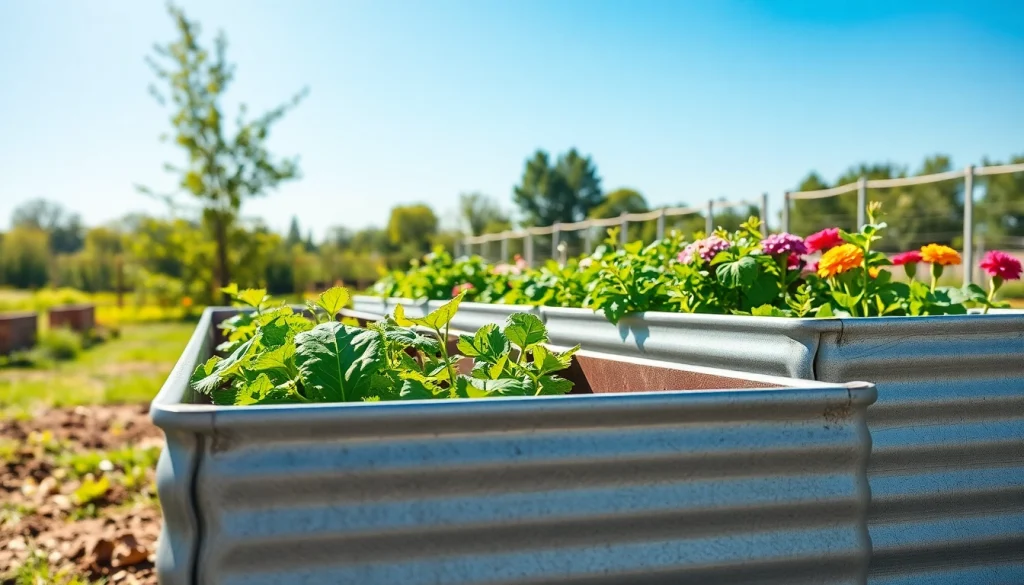Boost Your Garden’s Potential with Galvanized Raised Beds: Benefits and Best Practices

Understanding Galvanized Raised Beds
What Are Galvanized Raised Beds?
Galvanized raised beds are garden containers made from steel sheets that have been coated with a layer of zinc. This protective coating prevents rust and extends the lifespan of the metal, making these beds particularly robust for outdoor use. Designed to support soil and plants above ground level, galvanized raised beds come in various shapes and sizes, allowing for versatility in garden design. The combination of metal materials and raised structure enhances drainage, offers better soil quality management, and creates a more ergonomic gardening experience.
Benefits of Using Galvanized Raised Beds
Choosing galvanized raised beds comes with numerous advantages. First and foremost, they are highly durable, often lasting decades without significant wear and tear. Unlike wooden beds, which can rot over time, galvanized beds resist decay, thereby providing a more sustainable option for long-term gardening. Additionally, the height of these beds allows for improved drainage and weed control, creating an optimal environment for plant growth.
Moreover, they have a modern aesthetic that can complement various garden styles, from contemporary to rustic. The thermal mass of the metal can also contribute to soil temperature regulation, helping to create a warm environment conducive to plant growth in cooler climates. With galvanized raised beds, gardeners can enjoy a cleaner, more organized garden layout, reducing the need for extensive weeding and maintenance.
How Galvanized Raised Beds Compare to Other Options
When comparing galvanized raised beds to other gardening options, several factors come to light. Wood is a common alternative, but it lacks the longevity of galvanized steel, particularly when exposed to moisture and insects. Plastic raised beds are lightweight and versatile, but they often degrade faster under UV exposure and can become brittle over time. In contrast, galvanized raised beds offer resilience and structural integrity that can withstand various weather conditions.
Additionally, while wooden beds need regular sealing and maintenance to prevent rot, galvanized beds require minimal upkeep. The choice ultimately depends on personal preference regarding aesthetics, budget, and long-term garden planning.
Choosing the Right Galvanized Raised Bed for Your Needs
Factors to Consider When Selecting Galvanized Raised Beds
When selecting galvanized raised beds, several critical factors should influence your decision. Initially, consider the material thickness and gauge of the metal. Thicker materials generally provide greater durability and stability, which is essential if you plan to grow heavy plants or have a large garden. Another consideration is the height of the beds; taller beds are beneficial for people with mobility issues as they reduce the need to bend over.
Additionally, think about the bed design; some raised beds are designed with integrated shelves or benches, which can enhance functionality. Ventilation and drainage should also be factors. Well-designed beds have holes to allow for excess water to escape, preventing waterlogging and ensuring a healthier root system.
Size and Shape Options for Galvanized Raised Beds
Galvanized raised beds come in various sizes and shapes, making it easy to fit them into any garden layout. From small, rectangular beds ideal for limited spaces to large, sprawling units for extensive vegetable gardens, the options are abundant. Traditional rectangular beds are versatile, but circular and square configurations can offer distinct planting advantages, allowing for efficient use of space.
When deciding on size, consider the available space in your yard and the types of plants you wish to grow. For example, root vegetables may require deeper beds, while herbs might thrive in shallower configurations.
Custom Features for Enhanced Gardening Experience
Many gardeners enjoy customizing their raised beds to enhance their gardening experience. This can include adding features like trellises for climbing plants, integrated irrigation systems for efficient watering, and protective covers against pests. Some may opt for internal dividers to create separate planting zones within the same bed, allowing for better organization and crop rotation practices.
Additionally, installing wheels or casters on the beds can facilitate mobility, helping gardeners to re-position their beds according to changing light conditions or accessibility needs. Customization reflects personal gardening style and can significantly improve productivity.
Installation and Setup of Galvanized Raised Beds
Ideal Locations for Your Galvanized Raised Beds
The location of your galvanized raised beds can make a significant difference in gardening success. Ideally, choose a spot that receives at least 6-8 hours of sunlight daily to ensure plants receive the necessary energy for growth. Furthermore, ensure the drainage is adequate; avoid areas where rainwater collects to prevent waterlogging.
Other considerations include proximity to a water source for easy irrigation and the convenience of accessing the beds for maintenance tasks like weeding, harvesting, and monitoring plant health.
Step-by-Step Guide to Installing Galvanized Raised Beds
- Choose Your Site: Select a sunny, well-draining area to install your raised beds.
- Measure and Mark: Define the boundaries of your raised bed using stakes and string or spray paint.
- Prepare the Soil: Clear the area of grass and debris, and consider using landscape fabric to prevent weeds.
- Assemble the Bed: Follow the manufacturer’s instructions carefully to construct the bed, ensuring all pieces fit snugly.
- Fill with Soil: Use high-quality soil mix, usually a blend of topsoil, compost, and organic matter, to fill your raised bed.
- Plant: Choose suitable crops or plants and follow specific planting guidelines regarding spacing and depth.
- Water and Maintain: Once planted, water the beds adequately and plan for ongoing maintenance.
Soil and Plant Selection for Optimal Growth
Selecting the right soil mix is crucial for the health of plants in galvanized raised beds. A well-draining mix can include a blend of topsoil, organic compost, and perlite or vermiculite for aeration. The specific plants you choose will depend on your climate, growing season, and personal preferences, but it’s essential to pair plants with compatible growing conditions, such as light and water needs.
When in doubt, start with easier-to-grow plants, such as lettuce, herbs, or radishes, which are generally more forgiving for novice gardeners.
Maintenance Tips for Galvanized Raised Beds
Regular Care Practices for Longevity
Maintaining galvanized raised beds is relatively straightforward but requires regular attention to ensure their longevity and productivity. Start with regular watering and check soil moisture levels frequently, particularly during dry spells. Applying mulch on the soil surface can help retain moisture and keep roots cool.
Weed management is crucial; remove weeds promptly to prevent them from competing with your plants for nutrients. Regularly inspect plants for signs of pests or diseases, and take action immediately if issues arise to prevent further problems.
Winterizing Your Galvanized Raised Beds
In colder climates, winterizing your galvanized raised beds can help protect your soil structure and prepare for the growing season ahead. Start by clearing out dead plants and debris at the end of the growing season. Consider adding a layer of mulch or cover crops which can provide insulation, improve soil health, and suppress weeds over winter. Some gardeners choose to cover their beds with fabric or tarps to protect them from severe weather.
Dealing with Common Issues
Like any gardening endeavor, working with galvanized raised beds can come with challenges. Some issues include pest infestations, nutrient deficiencies, and soil erosion. To combat pests, implement natural deterrents like companion plantings or organic pesticides.
Nutrient deficiencies can often be addressed with regular fertilization, utilizing organic fertilizers to enhance soil health and productivity. Soil erosion can be prevented by applying mulch and maintaining healthy, dense vegetation to protect the topsoil.
Maximizing Garden Productivity with Galvanized Raised Beds
Crop Rotation Strategies for Galvanized Raised Beds
Implementing crop rotation can significantly enhance soil fertility and reduce pest and disease pressures in your raised beds. By rotating crops from one family to another, you can limit the accumulation of pests and diseases associated with specific plants. Additionally, different crops will utilize varied nutrients, giving the soil a chance to recuperate between planting cycles.
Plan a rotation strategy such as grouping plants into categories; for example, leafy greens, root vegetables, and legumes. This planning can further enhance the productivity of your galvanized raised beds over multiple seasons.
Companion Planting Tips for Enhanced Growth
Companion planting is an excellent method to enhance growth and deter pests naturally. For example, planting marigolds alongside vegetables can help repel harmful insects, while planting basil near tomatoes may improve their flavor and growth. Understanding the relationships between different plants can optimize the productivity of your galvanized raised beds.
Research common companion plants and their synergies, and evaluate your growing plan accordingly to create a thriving and diverse garden ecosystem.
Harvesting and Utilizing Your Bounty
Understanding the right time to harvest your crops is crucial for maximizing their taste and nutritional value. Most vegetables have an optimal harvesting window where flavor peaks; for instance, leafy greens are best when young and tender. Regularly assess your plants to determine the best harvest times, and do not hesitate to pick vegetables promptly to encourage further production.
Finally, consider how to utilize your harvest efficiently. Prepare dishes that feature your freshly grown produce or even preserve excess food for later use. This approach not only extends the enjoyment of your garden’s bounty but also helps reduce waste.







